Culture of Latin America
The Culture of Latin America is the formal or informal expression of the people of Latin America and includes both high culture (literature and high art) and popular culture (music, folk art, and dance), as well as religion and other customary practices. These are generally of Western origin, but have various degrees of Native American, African and Asian influence.
Definitions of Latin America vary. From a cultural perspective,[1] Latin America generally refers to those parts of the Americas whose cultural, religious and linguistic heritage can be traced to the Latin culture of the late Roman Empire. This would include areas where Spanish, Portuguese, French and various other Romance languages, which can trace their origin to the Vulgar Latin spoken in the late Roman Empire, are natively spoken. Such territories include almost all of Mexico, Central America and South America, with the exception of English or Dutch speaking territories. Culturally, it could also encompass the French derived culture in North America, as it ultimately derives from Latin Roman influence as well. There is also an important Latin American cultural presence in the United States since the 16th century in areas such as California, Texas and Florida, which were part of the Spanish Empire. More recently, in cities such as New York, Chicago, Dallas, Los Angeles, and Miami.
The richness of Latin American culture is the product of many influences, including:
- Iberian origin, which is ultimately related to Western Culture.
- Pre-Columbian cultures, whose importance is today particularly notable in countries such as Mexico, Guatemala, Ecuador, Peru, Bolivia, and Paraguay. These cultures are central to Indigenous communities such as the Quechua, Maya, and Aymara.
- 19th- and 20th-century European immigration from Spain, Portugal, Italy, Germany, France, and Eastern Europe; which transformed the region and had an impact in countries such as (particularly the northern region).
- Indian, Lebanese and other Arab, Armenian, Korean, Japanese and various other Asian groups. Mostly immigrants and indentured laborers who arrived from the coolie tradeand influenced the culture of Brazil, Colombia, Cuba, Panama, Nicaragua, Ecuador and Peru in areas such as food, art, and cultural trade.
- The culture of Africa brought by Africans in the Trans-Atlantic former slave trade has influenced various parts of Latin America. Influences are particularly strong in dance, music, cuisine, and some syncretic religions of Cuba, Brazil, Dominican Republic, Venezuela, Northwest Ecuador, coastal Colombia, and Honduras.[2][3][4]
Ethnic groups
The population of Latin America is very diverse with many
In the 16th, 17th and 18th centuries there was a flow of Spanish and Portuguese emigrants who left for Latin America. It was never a large movement of people, but over the long period of time it had a major impact on Latin American populations: the Portuguese left for Brazil and the Spaniards left for Central and South America. Of the European immigrants, men greatly outnumbered women and many married Natives. This resulted in a mixing of the Amerindians and Europeans and today their descendants are known as mestizos. Even Latin American criollos, of mainly European ancestry, usually have some Native ancestry. Today, mestizos make up the majority of Latin America's population.
Starting in the late 16th century, a large number of former African
Large numbers of
]In this same period, immigrants came from the Middle East and Asia, including
, mainly to Brazil. These people only make up a small percentage of Latin America's population but they have communities in the major cities.This diversity has profoundly influenced religion, music and politics. This cultural heritage is called Latino in American English.
Language

Other European languages spoken include Italian in Brazil and Uruguay, German in southern Brazil and southern Chile, and Welsh in southern Argentina.
Religion
The primary religion throughout Latin America is
Folklore
Arts and leisure
In long-term perspective, Britain's influence in Latin America was enormous after independence came in the 1820s. Britain deliberately sought to replace the Spanish and Portuguese in economic and cultural affairs. Military issues and colonization were minor factors. The influence was exerted through diplomacy, trade, banking, and investment in railways and mines. The English language and British cultural norms were transmitted by energetic young British business agents on temporary assignment in the major commercial centers, where they invited locals into the British leisure activities, such as organized sports, and into their transplanted cultural institutions such as schools and clubs. The British role never disappeared, but it faded rapidly after 1914 as the British cashed in their investments to pay for the Great War, and the United States, another Anglophone power, moved into the region with overwhelming force and similar cultural norms.[14]
Sports
The British impact on sports was overwhelming, as Latin America took up football (called fútbol in Spanish and futebol in Portuguese). In Argentina, rugby, polo, tennis and golf became important middle-class leisure pastimes.[15]
In some parts of the Caribbean and Central America baseball outshined soccer in terms of popularity. The sport started in the late 19th century when sugar companies imported cane cutters from the British Caribbean. During their free time, the workers would play cricket, but later, during the long period of US military occupation, cricket gave way to baseball, which rapidly assumed widespread popularity, although cricket remains the favorite in the British Caribbean. Baseball had the greatest following in those nations occupied at length by the US military, especially the Dominican Republic and Cuba, as well as Nicaragua, Panama, and Puerto Rico. Even Venezuela, which wasn't occupied by the US military during this time period, still became a popular baseball destination. All of these countries have emerged as sources of baseball talent, since many players hone their skills on local teams, or in “academies” managed by the US Major Leagues to cultivate the most promising young men for their own teams.[16]
Literature
Pre-Columbian cultures were primarily oral, though the Aztecs and Mayans, for instance, produced elaborate
From the very moment of Europe's "discovery" of the continent, early explorers and
The 19th century was a period of "foundational fictions" (in critic Doris Sommer's words), novels in the Romantic or Naturalist traditions that attempted to establish a sense of national identity, and which often focussed on the indigenous question or the dichotomy of "civilization or barbarism" (for which see, say, Domingo Sarmiento's Facundo (1845), Juan León Mera's Cumandá (1879), or Euclides da Cunha's Os Sertões (1902)).
At the turn of the 20th century, modernismo emerged, a poetic movement whose founding text was Rubén Darío's Azul (1888). This was the first Latin American literary movement to influence literary culture outside of the region, and was also the first truly Latin American literature, in that national differences were no longer so much at issue.[citation needed] José Martí, for instance, though a Cuban patriot, also lived in Mexico and the United States and wrote for journals in Argentina and elsewhere.
However, what really put Latin American literature on the global map was no doubt the literary
Contemporary literature in the region is vibrant and varied, ranging from the best-selling Paulo Coelho and Isabel Allende to the more avant-garde and critically acclaimed work of writers such as Giannina Braschi, Diamela Eltit, Ricardo Piglia, Roberto Bolaño or Daniel Sada. There has also been considerable attention paid to the genre of testimony, texts produced in collaboration with subaltern subjects such as Rigoberta Menchú. Finally, a new breed of chroniclers is represented by the more journalistic Carlos Monsiváis and Pedro Lemebel.
The region boasts six Nobel Prizewinners: in addition to the Colombian García Márquez (1982), also the Chilean poet Gabriela Mistral (1945), the Guatemalan novelist Miguel Ángel Asturias (1967), the Chilean poet Pablo Neruda (1971), the Mexican poet and essayist Octavio Paz (1990), and the Peruvian writer Mario Vargas Llosa (2010).
Philosophy
The history of Latin American philosophy is usefully divided into five periods:
Latina/o philosophy is a tradition of thought referring both to the work of many Latina/o philosophers in the United States and to a specific set of philosophical problems and method of questioning that relate to Latina/o identity as a hyphenated experience, borders,
Music
Latin American music comes in many varieties, from the simple, rural
Latin America can be divided into several
One of the main characteristics of Latin American music is its diversity, from the lively rhythms of Central America and the Caribbean to the more austere sounds of southern South America. Another feature of Latin American music is its original blending of the variety of styles that arrived in The Americas and became influential, from the early Spanish and European Baroque to the different beats of the African rhythms.
Latino-Caribbean music, such as salsa, merengue, bachata, etc., are styles of music that have been strongly influenced by African rhythms and melodies.[35][36]
Other musical genres of Latin America include the Argentine and Uruguayan
The classical composer Heitor Villa-Lobos (1887–1959) worked on the recording of native musical traditions within his homeland of Brazil. The traditions of his homeland heavily influenced his classical works.[38] Also notable is the much recent work of the Cuban Leo Brouwer and guitar work of the Venezuelan Antonio Lauro and the Paraguayan Agustín Barrios.
Arguably, the main contribution to music entered through folklore, where the true soul of the Latin American and Caribbean countries is expressed. Musicians such as Atahualpa Yupanqui, Violeta Parra, Víctor Jara, Mercedes Sosa, Jorge Negrete, Caetano Veloso, Yma Sumac and others gave magnificent examples of the heights that this soul can reach, for example:the Uruguayan born and first Latin American musician to win an OSCAR prize, Jorge Drexler.[39]
Film

Latin American film is both rich and diverse. But the main centers of production have been Mexico, Argentina, Brazil, and Cuba.

Latin American cinema flourished after the introduction of sound, which added a linguistic barrier to the export of Hollywood film south of the border. The 1950s and 1960s saw a movement towards Third Cinema, led by the Argentine filmmakers Fernando Solanas and Octavio Getino. More recently, a new style of directing and stories filmed has been tagged as "New Latin American Cinema."
Cuban cinema has enjoyed much official support since the Cuban revolution, and important filmmakers include Tomás Gutiérrez Alea.
Modern dance
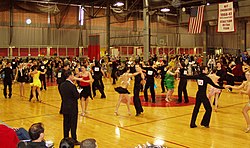
Latin America has a strong tradition of evolving dance styles. Some of its dance and music is considered to emphasize sexuality, and have become popular outside of their countries of origin. Salsa and the more popular Latin dances were created and embraced into the culture in the early and middle 1900s and have since been able to retain their significance both in and outside the Americas. The mariachi bands of Mexico stirred up quick paced rhythms and playful movements at the same time that Cuba embraced similar musical and dance styles. Traditional dances were blended with new, modern ways of moving, evolving into a blended, more contemporary forms.
Ballroom studios teach lessons on many Latin American dances. One can even find the cha-cha being done in honky-tonk country bars. Miami has been a large contributor of the United States' involvement in Latin dancing. With such a huge Puerto Rican and Cuban population one can find Latin dancing and music in the streets at any time of day or night.
Some of the dances of Latin America are derived from and named for the type of music they are danced to. For example,
Modern Latin American dancing is very energetic. These dances primarily are performed with a partner as a social dance, but solo variations exist. The dances emphasize passionate hip movements and the connection between partners. Many of the dances are done in a close embrace while others are more traditional and similar to ballroom dancing, holding a stronger frame between the partners.
Theatre
Theatre in Latin America existed before the Europeans came to the continent. The natives of Latin America had their own rituals, festivals, and ceremonies. They involved dance, singing of poetry, song, theatrical skits, mime, acrobatics, and magic shows. The performers were trained; they wore costumes, masks, makeup, wigs. Platforms had been erected to enhance visibility. The 'sets' were decorated with branches from trees and other natural objects.[41]
The Europeans used this to their advantage. For the first fifty years after the Conquest the missionaries used theatre widely to spread the Christian doctrine to a population accustomed to the visual and oral quality of spectacle and thus maintaining a form of cultural hegemony. It was more effective to use the indigenous forms of communication than to put an end to the 'pagan' practices, the conquerors took out the content of the spectacles, retained the trappings, and used them to convey their own message.[42]
Pre-Columbian rituals were how the indigenous came in contact with the divine. Spaniards used plays to Christianize and colonize the indigenous peoples of the Americas in the 16th century.[43] Theatre was a potent tool in manipulating a population already accustomed to spectacle. Theatre became a tool for political hold on Latin America by colonialist theatre by using indigenous performance practices to manipulate the population.[44]
Theatre provided a way for the indigenous people were forced to participate in the drama of their own defeat. In 1599, the Jesuits even used cadavers of Native Americans to portray the dead in the staging of the final judgment.[45]
While the plays were promoting a new sacred order, their first priority was to support the new secular, political order. Theatre under the colonizers primarily at the service of the administration.[42]
After the large decrease in the native population, the indigenous consciousness and identity in theatre disappeared, though pieces did have indigenous elements to them.[46] The theatre that progressed in Latin America is argued to be theatre that the conquerors brought to the Americas, not the theatre of the Americas.[47]
Progression in Postcolonial Latin American Theatre
Internal strife and external interference have been the drive behind Latin American history which applies the same to theatre.
1959–1968: dramaturgical structures and structures of social projects leaned more toward constructing a more native Latin American base called the "Nuestra America".
1968–1974: theatre tries to claim a more homogenous definition which brings in more European models. At this point, Latin American Theatre tried to connect to its historical roots.
1974–1984: the search for expression rooted in the history of Latin America became victims of exile and death.[48]

Latin American cuisine
Latin American cuisine refers to the typical foods, beverages, and cooking styles common to many of the countries and cultures in Latin America. Latin America is a very diverse region with cuisines that vary from nation to nation.
Some items typical of Latin American cuisine include
Latin American beverages are just as distinct as their foods. Some of the beverages can even date back to the times of the Native Americans. Some popular beverages include
Desserts in Latin America include dulce de leche, alfajor, arroz con leche, tres leches cake, Teja and flan.
Regional cultures
North America
Mexico


Historically, Mexicans have struggled with the creation of a united identity. This particular issue is the main topic of Mexican Nobel Prize winner Octavio Paz's book The Labyrinth of Solitude. Mexico is a large country with a large population, therefore having many cultural traits found only in some parts of the country. Northern Mexico is the least culturally diverse region due to its very low Native American population and high density of those of European descent. Northern Mexicans are also more Americanized due to the common border with the United States. Central and southern Mexico is where many well-known traditions find their origin, therefore the people from this area are in a way the most traditional, but their collective personality cannot be generalized. People from Puebla, for instance, are thought to be conservative and reserved, and just in the neighboring state of Veracruz, people have the fame of being outgoing and liberal. Chilangos (Mexico City natives) are believed to be a bit aggressive and self-centered. The regiomontanos (citizens from Monterrey) are thought to be rather proud and miserly, regardless of their social status. Almost every Mexican state has its own accent, making it fairly easy to distinguish the origin of someone by their use of language.
The
Other notable Mexican writers include poets such as
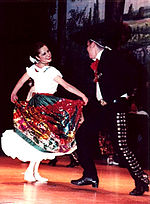
The
Prior to the foundation of Mexico as a nation-state, the original inhabitants of the land used drums (such as the
Mexicans in places like
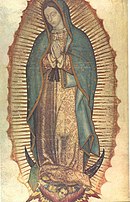
The standard of living in Mexico is higher than most of the other countries in Latin America attracting migrants in search for better opportunities. With the recent economic growth, many high-income families live in single houses, commonly found within a gated community, called "fraccionamiento". The reason these places are the most popular among the middle and upper classes is that they offer a sense of security and provide social status. Swimming pools or golf clubs, and/or some other commodities are found in these fraccionamientos. Poorer Mexicans, by contrast, live a harsh life, although they share the importance they grant to family, friends and cultural habits.
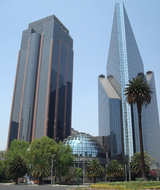
Two of the major television networks based in Mexico are
Mexico's national sports are
Central America
This section needs expansion. You can help by adding to it. (June 2008) |
Guatemala

The culture of Guatemala reflects strong Mayan and Spanish influences and continues to be defined as a contrast between poor Mayan villagers in the rural highlands, and the urbanized and wealthy mestizos population who occupy the cities and surrounding agricultural plains.

The
The
Guatemalan literature is famous around the world whether in the indigenous languages present in the country or in Spanish. Though there was likely literature in Guatemala before the arrival of the Spanish, all the texts that exist today were written after their arrival. The

The
Nicaragua

Nicaraguan music is a mixture of indigenous and European, especially Spanish and to a lesser extent German, influences. The latter was a result of the German migration to the central-north regions of Las Segovias where Germans settled and brought with them polka music which influenced and evolved into Nicaraguan mazurka, polka and waltz. The Germans that migrated to Nicaragua are speculated to have been from the regions of Germany which were annexed to present-day Poland following the Second World War; hence the genres of mazurka, polka in addition to the waltz. One of the more famous composers of classical music and Nicaraguan waltz was José de la Cruz Mena who was actually not from the northern regions of Nicaragua but rather from the city of Leon in Nicaragua.
More nationally identified, however, are musical instruments such as the
El Güegüense is a satirical drama and was the first literary work of post-Columbian Nicaragua. It is regarded as one of Latin America's most distinctive colonial-era expressions and as Nicaragua's signature folkloric masterpiece combining music, dance and theater.[51] The theatrical play was written by an anonymous author in the 16th century, making it one of the oldest indigenous theatrical/dance works of the Western Hemisphere.[52] The story was published in a book in 1942 after many centuries.[53]
South America
Andean states
The Andes Region comprises roughly much of what is now Venezuela, Colombia, Peru, Chile, Ecuador, and Bolivia, and was the seat of the Inca Empire in the pre-Columbian era. As such, many of the traditions date back to Incan traditions.
During the independization of the Americas many countries including Venezuela, Colombia, and Ecuador and Panama formed what was known as Gran Colombia, a federal republic that later dissolved, however, the people in these countries believe each other to be their brothers and sisters and as such share many traditions and festivals. Peru and Bolivia were also one single country until Bolivia declared its independence, nevertheless, both nations are close neighbors that have somewhat similar cultures.
Bolivia and Peru both still have significant Native American populations (primarily Quechua and Aymara) which mixed Spanish cultural elements with their ancestors' traditions. The Spanish-speaking population mainly follows the Western customs. Important archaeological ruins, gold and silver ornaments, stone monuments, ceramics, and weavings remain from several important pre-Columbian cultures. Major Bolivian ruins include Tiwanaku, Samaipata, Incallajta, and Iskanwaya.
The majority of the Ecuadorian population is mestizo, a mixture of both European and Amerindian ancestry, and much like their ancestry, the national culture is also a blend of these two sources, along with influences from slaves from Africa in the coastal region. 95% of Ecuadorians are Roman Catholic.
Peru
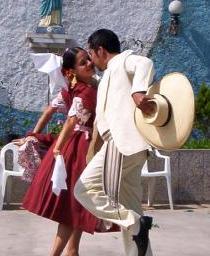
Peruvian culture is primarily rooted in Amerindian and Spanish traditions,[54] though it has also been influenced by various African, Asian, and a European ethnic group.
Colombia
This article needs additional citations for verification. (March 2017) |
The culture of Colombia lies at the crossroads of Latin America. Thanks partly to geography, Colombian culture has been heavily fragmented into five major cultural regions. Rural to urban migration and globalization have changed how many Colombians live and express themselves as large cities become melting pots of people (many of whom are refugees) from the various provinces.[citation needed] According to a study in late 2004 by the Erasmus University in Rotterdam, Colombians are one of the happiest people in the world; this despite its four-decade long armed conflict involving the government, paramilitaries, drug lords, corruption and guerrillas like the FARC and ELN. [citation needed]
Many aspects of Colombian culture can be traced back to the
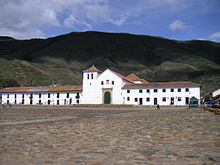
Ethno-racial groups maintained their ancestral heritage culture: whites tried to keep themselves, despite the growing number of illegitimate children of mixed African or indigenous ancestry. These people were labeled with any number of descriptive names, derived from the casta system, such as
The industrial revolution arrived relatively late at the beginning of the 20th century with the establishment of the
Bogotá, the principal city, was the World Book Capital in 2007, in 2008 by the Iberoamerican Theatrum Festival Bogotá has been proclaimed as the world capital of theatre.
Venezuela

Venezuelan culture has been shaped by indigenous, African and especially European Spanish. Before this period, indigenous culture was expressed in art (petroglyphs), crafts, architecture (shabonos), and social organization. Aboriginal culture was subsequently assimilated by Spaniards; over the years, the hybrid culture had diversified by region.
At present the Indian influence is limited to a few words of vocabulary and gastronomy. The African influence in the same way, in addition to musical instruments like the drum. The Spanish influence was more important and in particular came from the regions of Andalusia and Extremadura, places of origin of most settlers in the Caribbean during the colonial era. As an example of this can include buildings, part of the music, the Catholic religion and language. Spanish influences are evident bullfights and certain features of the cuisine. Venezuela also enriched by other streams of Indian and European origin in the 19th century, especially France. In the last stage of the great cities and regions entered the U.S. oil source and demonstrations of the new immigration of Spanish, Italian and Portuguese, increasing the already complex cultural mosaic. For example: From the United States comes the influence of the taste of baseball and modern architectural structures


Carlos Raúl Villanueva was the most important Venezuelan architect of the modern era; he designed the Central University of Venezuela, (a World Heritage Site) and its Aula Magna. Other notable architectural works include the Capitol, the Baralt Theatre, the Teresa Carreño Cultural Complex, and the General Rafael Urdaneta Bridge.
Brazil
This section needs expansion. You can help by adding to it. (June 2008) |
- Theatre
In the 19th century, Brazilian theatre began with romanticism along with a fervour for political independence.[72] During this time, racial issues were discussed in contradictory terms, but even so, there were some significant plays, including a series of popular comedies by Martins Penna, França Junior, and Arthur Azevedo.[73]
In the 20th century, the two most important production centers for professional theatre were São Paulo and Rio de Janeiro. They were centers of industrial and economic development.[73] Even with the development of these two theatres, World War I brought an end to tours by European theatres so there were no productions in Brazil during this time.
In November 1927, Alvaro Moreyra founded the Toy Theatre (Teatro de Brinquedo). Like this company, it was in the late 1920s when the first stable theatre companies formed around well-known actors. These actors were able to practice authentic Brazilian gestures gradually freed from Portuguese influence. Except for some political criticism in the low comedies, the dramas of this period were not popular. Occasionally the question of dependence on Europe or North America has raised.[73] Even with more Latin American influence of theatre starting to filter in, its theatre still was under the heavy influence of Europe.
The Brazilian Comedy Theatre (Teatro Brasileiro de Comédia) was created in 1948
Oswald de Andrade wrote three plays; The King of the Candle (O Rei da Vela, 1933), The Man and the Horse (O Homem e o Cavalo, 1934). and The Dead Woman (A Morta, 1937). They were an attempt to deal with political themes, nationalism, and anti-imperialism. His theatre was inspired by Meyerhold's and Brecht's theories, with a political sarcasm like Mayakovsky.[74]
1943 at The Comedians: Polish director and refugee from the Nazis, Zbigniew Ziembinsky, staged in expressionist style Nelson Rodrigues' A Bride's Gown (Vestido de Noiva). With this production, Brazilian theatre moved into the modem period at Theatre Brasileiro de Commedia (Brazilian Comedy Theater).[75]
World War II saw Brazil gain several foreign directors, especially from Italy, who wanted to make a theatre free from nationalistic overtones. Paradoxically, this led to a second renewal that engaged popular forms and sentiments; a renewal that was decidedly nationalistic with social point of view.[75]
During this time, the Stanislavsky system of acting was most popular and widely used. Stanislavski himself came to Brazil via Eugenio Kusnet, a Russian actor who had met him at the Moscow Art Theatre.
The next phase was from 1958 to the signing of the Institutional Act Number Five in 1968. It marked the end of freedom and democracy. These ten years were the most productive of the century. During these years dramaturgy matured through the plays of Guarnieri, Vianinha, Boal, Dias Gomes, and Chico de Assis, as did mise-en-scene in the work of Boal, Jost Celso Martinez Correa, Flavio Rangel, and Antunes Filho. During this decade a generation accepted theatre as an activity with social responsibility.[76]
At its height, this phase of Brazilian theatre was characterized by an affirmation of national values. Actors and directors became political activists who risked their jobs and lives daily.[77]
Through this growth of Latin America politically and the influence of European theatre, an identity of what is theatre in Latin America stemmed out of it.
- Modern painting
Modern painting in Brazil was born during Modern Art Week in 1922. Artists who have excelled in 20th century Brazilian art include Tarsila do Amaral, Emiliano Di Cavalcanti, and Candido Portinari. Portinari was influenced by Cubism and Expressionism and is the painter of War and Peace, a panel at the United Nations in New York.
- Photography

Brazilian contemporary photography is one of the most creative in Latin America, growing in international prominence each year with exhibitions and publications. Photographers like Miguel Rio Branco, Vik Muniz, Sebastião Salgado, and Guy Veloso have received recognition.[citation needed]
The Río de la Plata region
This section needs expansion. You can help by adding to it. (June 2008) |
See also
- Culture and society in the Spanish Colonial Americas
- Culture of South America
- Hispanic culture
- Arts by region
- Sumak Kawsay
References
- ^ Sérgio Campos Gonçalves, “Cultura popular e suas representações: caminhos possíveis de reflexão”, Revista História em Reflexão - Programa de Pós-graduação em História – Faculdade de Ciências Humanas – UFGD (Dourados), v. 2, p. 1-19, 2008.
- . Retrieved 2022-02-15.
- )
- ^ a b "Spotlight on Garifuna history and reparation with Jóse Francisco Ávila". 18 July 2021.
- . Retrieved 2022-02-15.
- )
- ^ Facts of Basilica of Aparecida
- ^ Christians – Pew Research Center
- ^ "Las religiones en tiempos del Papa Francisco" (in Spanish). Latinobarómetro. April 2014. p. 7. Archived from the original (pdf) on 10 May 2015. Retrieved 4 April 2015.
- ^ "Religion in Latin America, Widespread Change in a Historically Catholic Region". pewforum.org. Pew Research Center, November 13, 2014. 13 November 2014. Retrieved March 4, 2015.
- ^ Travis Kitchens (June 21, 2010). "Chomsky on Religion". Archived from the original on 2021-12-21. Retrieved October 17, 2017 – via YouTube.
- ^ Paul Sigmund. "Education and Religious Freedom in Latin America". Princeton University. Retrieved 2006-05-21.
- ^ "The Global Religious Landscape" (PDF). Pewforum.org. Archived from the original (PDF) on 25 January 2017. Retrieved 7 May 2020.
- ^ Oliver Marshall, ed. English-Speaking Communities in Latin America (2000).
- ISBN 9780714651262.
- Teresa A. Meade, History of Modern Latin America: 1800 to the Present (2016), pp. 21–21.
- ^ Gracia, Jorge; Vargas, Manuel (2018), "Latin American Philosophy", in Zalta, Edward N. (ed.), The Stanford Encyclopedia of Philosophy (Summer 2018 ed.), Metaphysics Research Lab, Stanford University, retrieved 2020-08-08
- ^ a b "Latin American Philosophy". Internet Encyclopedia of Philosophy. Retrieved 2020-08-08.
- ISBN 9780534621582.
- ISBN 9780674821064. Retrieved 2020-08-08.
- ^ "Teaching Women's History: Sor Juana Inés de la Cruz". Women at the Center. 2018-05-22. Retrieved 2020-08-08.
- ^ "BIOGRAPHY – FIU Jose Marti Celebration". Retrieved 2020-08-08.
- ^ Gregory D. Gilson, and Irving W. Levinson, eds. Latin American Positivism: New Historical and Philosophic Essays (Lexington Books; 2012)
- ISBN 9780312210267.
- JSTOR 1770341.
- ^ "Works by Ofelia Schutte - PhilPapers". philpapers.org. Retrieved 2020-08-08.
- ^ Cline, Julie (2014-03-11). "Preeminent Philosopher Linda Martin Alcoff to Speak at W&L". The Columns. Retrieved 2020-08-08.
- ^ Aldama, Frederick Luis. "Poets, Philosophers, Lovers: On the Writings of Giannina Braschi". upittpress.org. Retrieved 2020-08-08.
- OCLC 53331582.
- S2CID 212759434.
- OCLC 1143649021.
- ^ a b "History of Latino/a Philosophy". obo. Retrieved 2020-08-08.
- ^ Morales, pg. xi
- ISBN 9780313087943.
- ^ Dr. Christopher Washburne. "Clave: The African Roots of Salsa". University of Salsa. Retrieved 2006-05-23.
- ^ "Guide to Latin Music". Caravan Music. Retrieved 2006-05-23.
- ^ "Daddy Yankee leads the reggaeton charge". Associated Press. Retrieved 2006-05-23.
- ^ "Heitor Villa-Lobos". Leadership Medica. Archived from the original on 2006-08-11. Retrieved 2006-05-23.
- ^ Barteldes, Ernest (April 2007). "Jorge Drexler The Road From Hollywood". Global Rhythm.
- ^ The Baltimore Sun. "Latin music returns to America with wave of new pop starlets". The Michigan Daily. Archived from the original on 2005-08-30. Retrieved 2006-05-23.
- ^ Taylor, Diana. Theatre of Crisis: Drama and Politics in Latin America. University Press of Kentucky (Lexington: 1991). 23
- ^ a b Taylor, Diana. 28.
- ^ Taylor, Diana. 1
- ^ Versényi, Adam. Theatre in Latin America: Religion, Politics, and Culture from Cortés to the 1980s. Cambridge University Press (New York: 1993) 56.
- ^ Taylor, Diana. 1.
- ^ Taylor, Diana. 29.
- ^ Taylor, Diana. 23.
- ^ Pianca, Marina. "Postcolonial Discourse in Latin American Theatre". Theatre Journal. Vol. 41, No. 4, Theatre and Hegemony. (Dec., 1989), 515–523.
- ^ "Western literature | History, Characteristics, Books, Authors, Examples, & Facts | Britannica".
- ^ Marco Velázquez and Mary Kay Vaughan, "Mestizaje and Musical Nationalism in Mexico" in The Eagle and the Virgin: Nation and Cultural Revolution in Mexico, 1920–1940. Mary Kay Vaughan and Stephen E. Lewis, Eds. Durham: Duke University Press 2006, p. 95.
- ^ a b "Showcasing Nicaragua's Folkloric Masterpiece - El Gueguense - and Other Performing and Visual Arts". Encyclopedia.com. Retrieved 2007-08-03.
- ^ "Native Theatre: El Gueguense". Smithsonian Institution. Archived from the original on 2007-12-06. Retrieved 2007-08-03.
- ^ "El Güegüense o Macho Ratón". ViaNica. Retrieved 2007-08-03.
- ^ Víctor Andrés Belaunde, Peruanidad, p. 472.
- ^ Gauvin Alexander Bailey, Art of colonial Latin America, pp. 72–74.
- ^ Gauvin Alexander Bailey, Art of colonial Latin America, p. 263.
- ^ Edward Lucie-Smith, Latin American art of the 20th century, pp. 76–77, 145–146.
- ^ Damián Bayón, "Art, c. 1920–c. 1980", pp. 425–428.
- ^ Gerald Martin, "Literature, music and the visual arts, c. 1820–1870", pp. 37–39.
- ^ Gerald Martin, "Narrative since c. 1920", pp. 151–152.
- ^ Gerald Martin, "Narrative since c. 1920", pp. 178–179.
- ^ Jaime Concha, "Poetry, c. 1920–1950", pp. 250–253.
- ^ Gerald Martin, "Narrative since c. 1920", pp. 186–188.
- ^ Tony Custer, The Art of Peruvian Cuisine, pp. 17–22.
- ^ Tony Custer, The Art of Peruvian Cuisine, pp. 25–38.
- ^ Embassy of Peru in the United States, The Peruvian Gastronomy Archived 2007-05-21 at the Wayback Machine. Retrieved on May 15, 2007
- ^ Raúl Romero, "Andean Peru", p. 385–386.
- ^ Dale Olsen, Music of El Dorado, pp. 17–22.
- ^ Thomas Turino, "Charango", p. 340.
- ^ Raúl Romero, "La música tradicional y popular", pp. 263–265.
- ^ Raúl Romero, "La música tradicional y popular", pp. 243–245, 261–263.
- ^ Peixoto, Fernando; Susana Epstein; Richard Schechner. Brazilian Theatre and National Identity. TDR (1988), Vol. 34, No. 1. (Spring, 1990) 61
- ^ a b c Peixoto, Fernando. 61
- ^ Peixoto, Fernando. 62
- ^ a b Peixoto, Fernando. 63
- ^ Piexoto, Fernando. 65
- ^ Piexoto, Fernando. 66
Bibliography
- Alonso, Paul. Satiric TV in the Americas: Critical Metatainment as Negotiated Dissent. Oxford University Press, 2018.
- Bailey, Gauvin Alexander. Art of colonial Latin America. London: Phaidon, 2005.
- Bayón, Damián. "Art, c. 1920–c. 1980". In: Leslie Bethell (ed.), A cultural history of Latin America. Cambridge: University of Cambridge, 1998, pp. 393–454.
- (in Spanish) Belaunde, Víctor Andrés. Peruanidad. Lima: BCR, 1983.
- Concha, Jaime. "Poetry, c. 1920–1950". In: Leslie Bethell (ed.), A cultural history of Latin America. Cambridge: University of Cambridge, 1998, pp. 227–260.
- Custer, Tony. The Art of Peruvian Cuisine. Lima: Ediciones Ganesha, 2003.
- Lucie-Smith, Edward. Latin American art of the 20th century. London: Thames and Hudson, 1993.
- Martin, Gerald. "Literature, music and the visual arts, c. 1820–1870". In: Leslie Bethell (ed.), A cultural history of Latin America. Cambridge: University of Cambridge, 1998, pp. 3–45.
- Martin, Gerald. "Narrative since c. 1920". In: Leslie Bethell (ed.), A cultural history of Latin America. Cambridge: University of Cambridge, 1998, pp. 133–225.
- Olsen, Dale. Music of El Dorado: the ethnomusicology of ancient South American cultures. Gainesville: University Press of Florida, 2002.
- (in Spanish) Romero, Raúl. "La música tradicional y popular". In: Patronato Popular y Porvenir, La música en el Perú. Lima: Industrial Gráfica, 1985, pp. 215–283.
- Romero, Raúl. "Andean Peru". In: John Schechter (ed.), Music in Latin American culture: regional tradition. New York: Schirmer Books, 1999, pp. 383–423.
- Turino, Thomas. "Charango". In: Stanley Sadie (ed.), The New Grove Dictionary of Musical Instruments. New York: MacMillan Press Limited, 1993, vol. I, p. 340.
External links
- Latin American Culture Library of Congress
- Mexican Celebrations ERIC
- Latino History and Culture Smithsonian Institution
- Archaeology of Ecuador
- Sounds and Colours Magazine exploring Latin American music and culture
- Latineos Latin America, Caribbean, arts and culture
